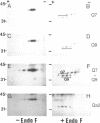Abstract
A feature of the expression of the tissue-specific class I antigen Qa-2 is the quantitative variation among mouse strains. Recently, the class I gene Q7 has been shown to encode a protein product that is biochemically indistinguishable from the lymphocyte-bound Qa-2 molecule. Utilizing gene transfection, we have identified a second Qa-2 subregion class I gene (Q9), in H-2b mice, which encodes a polypeptide biochemically similar to the Q7 and the Qa-2 polypeptides. Furthermore, we have observed that cell lines transfected with the allelic forms of the Q7 gene from C57BL/10 (Qa-2hi) or BALB/C (Qa-2low) display quantitative differences in cell-surface expression. Based on these studies, we suggest that gene dosage and allele-specific variation in cell-surface expression contribute to the strain-specific variation in the levels of Qa-2 antigen expression.
Full text
PDF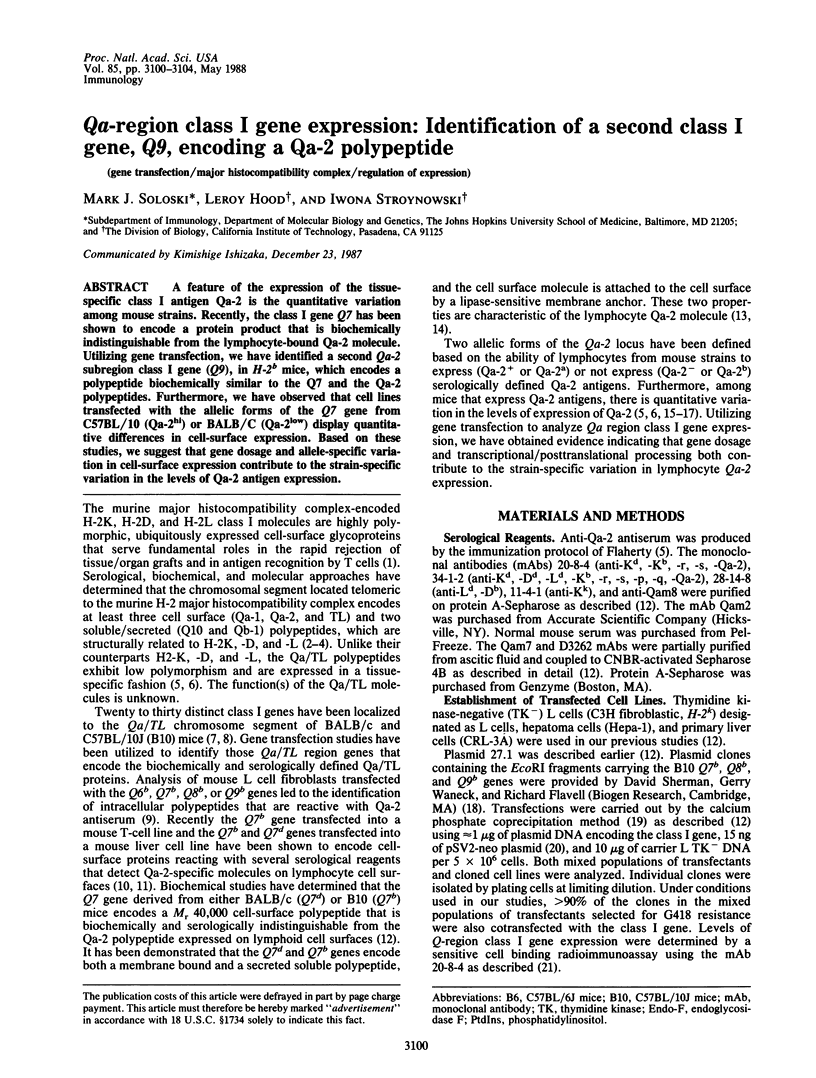
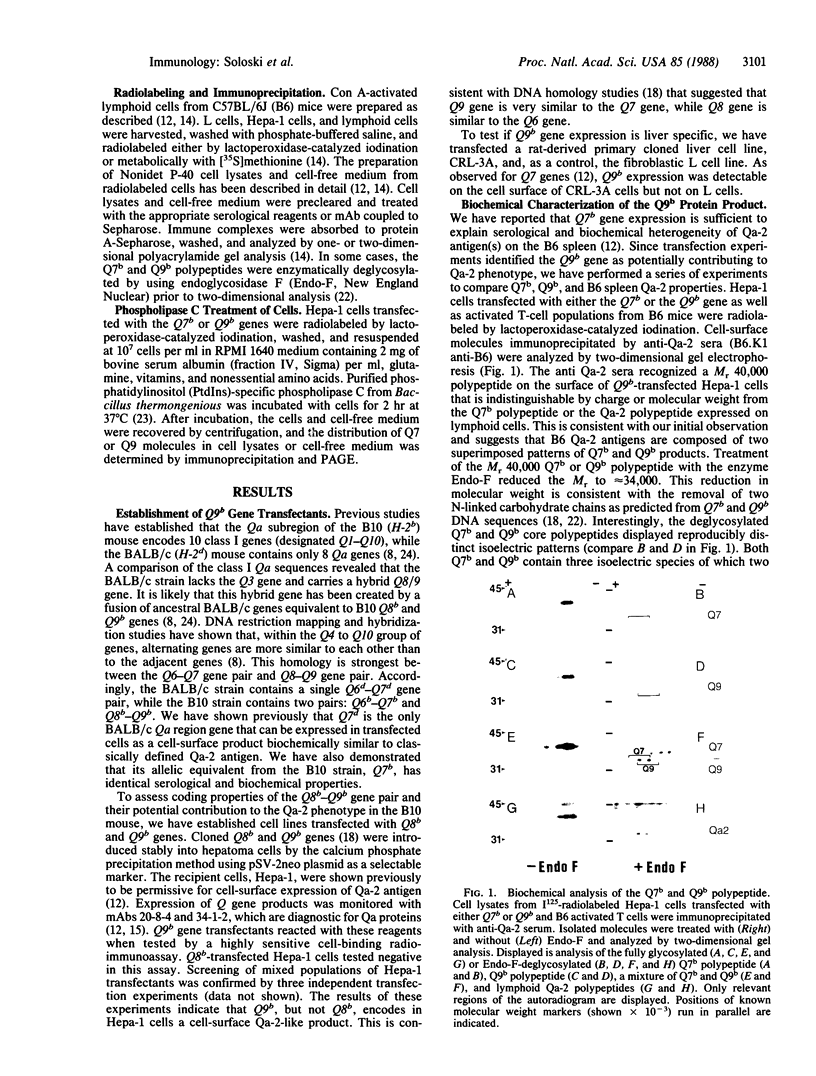
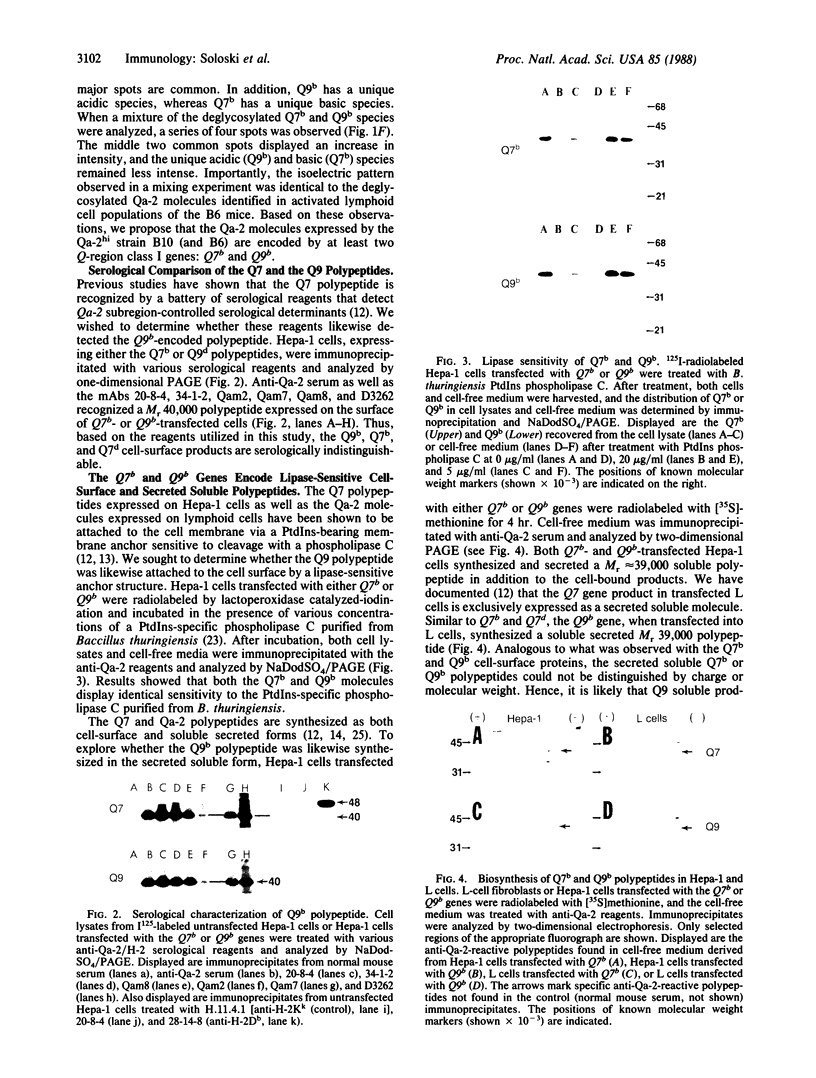
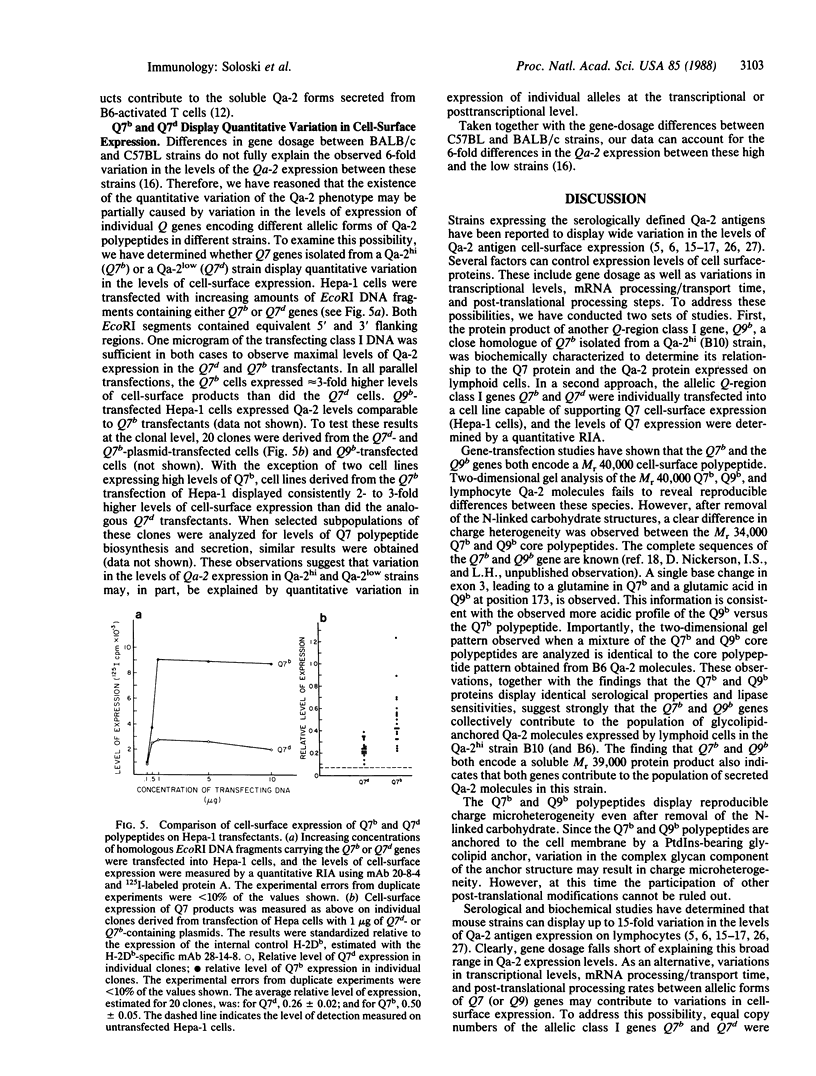
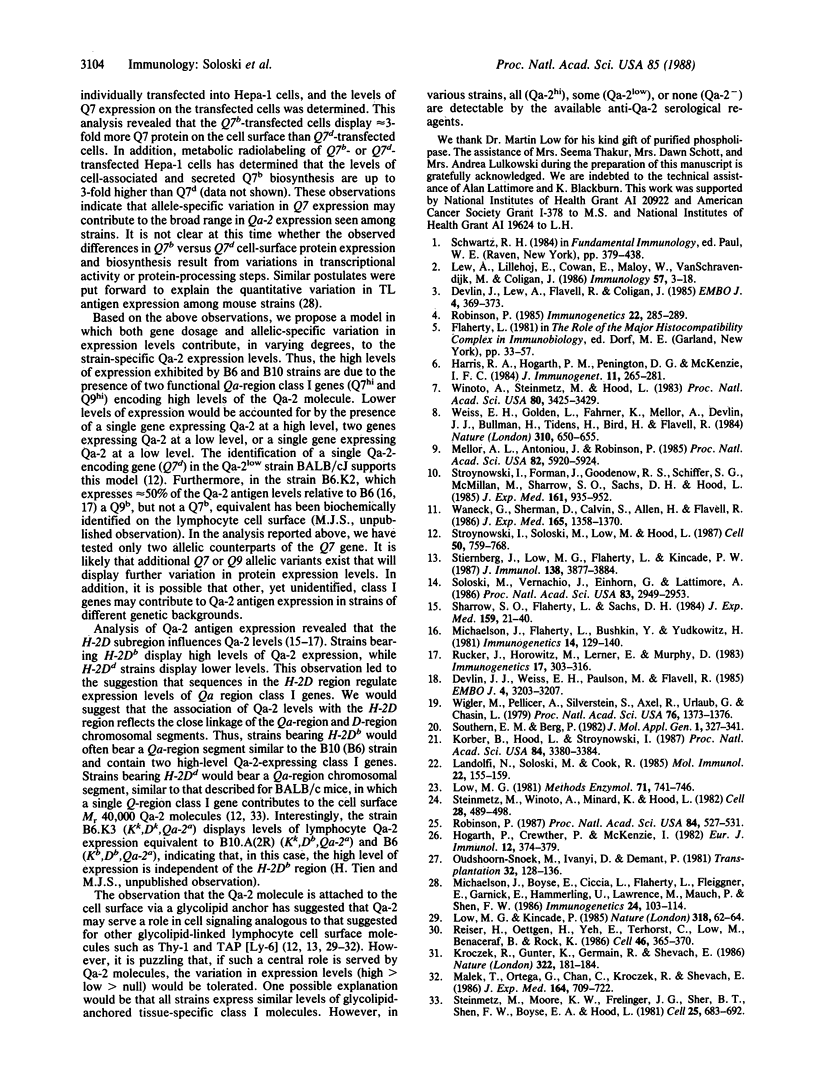
Images in this article
Selected References
These references are in PubMed. This may not be the complete list of references from this article.
- Devlin J. J., Lew A. M., Flavell R. A., Coligan J. E. Secretion of a soluble class I molecule encoded by the Q10 gene of the C57BL/10 mouse. EMBO J. 1985 Feb;4(2):369–374. doi: 10.1002/j.1460-2075.1985.tb03638.x. [DOI] [PMC free article] [PubMed] [Google Scholar]
- Devlin J. J., Weiss E. H., Paulson M., Flavell R. A. Duplicated gene pairs and alleles of class I genes in the Qa2 region of the murine major histocompatibility complex: a comparison. EMBO J. 1985 Dec 1;4(12):3203–3207. doi: 10.1002/j.1460-2075.1985.tb04066.x. [DOI] [PMC free article] [PubMed] [Google Scholar]
- Harris R. A., Hogarth P. M., Penington D. G., McKenzie I. F. Qa antigens and their differential distribution on lymphoid, myeloid and stem cells. J Immunogenet. 1984 Oct-Dec;11(5-6):265–281. doi: 10.1111/j.1744-313x.1984.tb00814.x. [DOI] [PubMed] [Google Scholar]
- Hogarth P. M., Crewther P. E., McKenzie I. F. Description of a Qa-2 like alloantigen (Qa-m2). Eur J Immunol. 1982 May;12(5):374–379. doi: 10.1002/eji.1830120504. [DOI] [PubMed] [Google Scholar]
- Korber B., Hood L., Stroynowski I. Regulation of murine class I genes by interferons is controlled by regions located both 5' and 3' to the transcription initiation site. Proc Natl Acad Sci U S A. 1987 May;84(10):3380–3384. doi: 10.1073/pnas.84.10.3380. [DOI] [PMC free article] [PubMed] [Google Scholar]
- Kroczek R. A., Gunter K. C., Germain R. N., Shevach E. M. Thy-1 functions as a signal transduction molecule in T lymphocytes and transfected B lymphocytes. Nature. 1986 Jul 10;322(6075):181–184. doi: 10.1038/322181a0. [DOI] [PubMed] [Google Scholar]
- Landolfi N. F., Soloski M. J., Cook R. G. Molecular weight diversity among murine class I antigens: both the mature cell surface forms and the unglycosylated polypeptides vary significantly in molecular weight. Mol Immunol. 1985 Feb;22(2):155–158. doi: 10.1016/s0161-5890(85)80009-2. [DOI] [PubMed] [Google Scholar]
- Lew A. M., Lillehoj E. P., Cowan E. P., Maloy W. L., van Schravendijk M. R., Coligan J. E. Class I genes and molecules: an update. Immunology. 1986 Jan;57(1):3–18. [PMC free article] [PubMed] [Google Scholar]
- Low M. G., Kincade P. W. Phosphatidylinositol is the membrane-anchoring domain of the Thy-1 glycoprotein. Nature. 1985 Nov 7;318(6041):62–64. doi: 10.1038/318062a0. [DOI] [PubMed] [Google Scholar]
- Low M. G. Phosphatidylinositol-specific phospholipase C from Staphylococcus aureus. Methods Enzymol. 1981;71(Pt 100):741–746. doi: 10.1016/0076-6879(81)71087-5. [DOI] [PubMed] [Google Scholar]
- Malek T. R., Ortega G., Chan C., Kroczek R. A., Shevach E. M. Role of Ly-6 in lymphocyte activation. II. Induction of T cell activation by monoclonal anti-Ly-6 antibodies. J Exp Med. 1986 Sep 1;164(3):709–722. doi: 10.1084/jem.164.3.709. [DOI] [PMC free article] [PubMed] [Google Scholar]
- Mellor A. L., Antoniou J., Robinson P. J. Structure and expression of genes encoding murine Qa-2 class I antigens. Proc Natl Acad Sci U S A. 1985 Sep;82(17):5920–5924. doi: 10.1073/pnas.82.17.5920. [DOI] [PMC free article] [PubMed] [Google Scholar]
- Michaelson J., Boyse E. A., Ciccia L., Flaherty L., Fleissner E., Garnick E., Hämmerling U., Lawrence M., Mauch P., Shen F. W. Biochemical genetics of TL antigens. Immunogenetics. 1986;24(2):103–114. doi: 10.1007/BF00373117. [DOI] [PubMed] [Google Scholar]
- Michaelson J., Flaherty L., Bushkin Y., Yudkowitz H. Further biochemical data on Qa-2. Immunogenetics. 1981;14(1-2):129–140. doi: 10.1007/BF00344306. [DOI] [PubMed] [Google Scholar]
- Oudshoorn-Snoek M., Iványi D., Démant P. Qualitative and quantitative aspects of anti-H-2Ld sera. Transplantation. 1981 Aug;32(2):128–136. doi: 10.1097/00007890-198108000-00009. [DOI] [PubMed] [Google Scholar]
- Reiser H., Oettgen H., Yeh E. T., Terhorst C., Low M. G., Benacerraf B., Rock K. L. Structural characterization of the TAP molecule: a phosphatidylinositol-linked glycoprotein distinct from the T cell receptor/T3 complex and Thy-1. Cell. 1986 Nov 7;47(3):365–370. doi: 10.1016/0092-8674(86)90593-3. [DOI] [PubMed] [Google Scholar]
- Robinson P. J. Qb-1, a new class I polypeptide encoded by the Qa region of the mouse H-2 complex. Immunogenetics. 1985;22(3):285–289. doi: 10.1007/BF00404488. [DOI] [PubMed] [Google Scholar]
- Robinson P. J. Two different biosynthetic pathways for the secretion of Qa region-associated class I antigens by mouse lymphocytes. Proc Natl Acad Sci U S A. 1987 Jan;84(2):527–531. doi: 10.1073/pnas.84.2.527. [DOI] [PMC free article] [PubMed] [Google Scholar]
- Rucker J., Horowitz M., Lerner E. A., Murphy D. B. Monoclonal antibody reveals H-2-linked quantitative and qualitative variation in the expression of a Qa-2 region determinant. Immunogenetics. 1983;17(3):303–316. doi: 10.1007/BF00364414. [DOI] [PubMed] [Google Scholar]
- Sharrow S. O., Flaherty L., Sachs D. H. Serologic cross-reactivity between Class I MHC molecules and an H-2-linked differentiation antigen as detected by monoclonal antibodies. J Exp Med. 1984 Jan 1;159(1):21–40. doi: 10.1084/jem.159.1.21. [DOI] [PMC free article] [PubMed] [Google Scholar]
- Soloski M. J., Vernachio J., Einhorn G., Lattimore A. Qa gene expression: biosynthesis and secretion of Qa-2 molecules in activated T cells. Proc Natl Acad Sci U S A. 1986 May;83(9):2949–2953. doi: 10.1073/pnas.83.9.2949. [DOI] [PMC free article] [PubMed] [Google Scholar]
- Southern P. J., Berg P. Transformation of mammalian cells to antibiotic resistance with a bacterial gene under control of the SV40 early region promoter. J Mol Appl Genet. 1982;1(4):327–341. [PubMed] [Google Scholar]
- Steinmetz M., Moore K. W., Frelinger J. G., Sher B. T., Shen F. W., Boyse E. A., Hood L. A pseudogene homologous to mouse transplantation antigens: transplantation antigens are encoded by eight exons that correlate with protein domains. Cell. 1981 Sep;25(3):683–692. doi: 10.1016/0092-8674(81)90175-6. [DOI] [PubMed] [Google Scholar]
- Steinmetz M., Winoto A., Minard K., Hood L. Clusters of genes encoding mouse transplantation antigens. Cell. 1982 Mar;28(3):489–498. doi: 10.1016/0092-8674(82)90203-3. [DOI] [PubMed] [Google Scholar]
- Stiernberg J., Low M. G., Flaherty L., Kincade P. W. Removal of lymphocyte surface molecules with phosphatidylinositol-specific phospholipase C: effects on mitogen responses and evidence that ThB and certain Qa antigens are membrane-anchored via phosphatidylinositol. J Immunol. 1987 Jun 1;138(11):3877–3884. [PubMed] [Google Scholar]
- Stroynowski I., Forman J., Goodenow R. S., Schiffer S. G., McMillan M., Sharrow S. O., Sachs D. H., Hood L. Expression and T cell recognition of hybrid antigens with amino-terminal domains encoded by Qa-2 region of major histocompatibility complex and carboxyl termini of transplantation antigens. J Exp Med. 1985 May 1;161(5):935–952. doi: 10.1084/jem.161.5.935. [DOI] [PMC free article] [PubMed] [Google Scholar]
- Stroynowski I., Soloski M., Low M. G., Hood L. A single gene encodes soluble and membrane-bound forms of the major histocompatibility Qa-2 antigen: anchoring of the product by a phospholipid tail. Cell. 1987 Aug 28;50(5):759–768. doi: 10.1016/0092-8674(87)90334-5. [DOI] [PubMed] [Google Scholar]
- Waneck G. L., Sherman D. H., Calvin S., Allen H., Flavell R. A. Tissue-specific expression of cell-surface Qa-2 antigen from a transfected Q7b gene of C57BL/10 mice. J Exp Med. 1987 May 1;165(5):1358–1370. doi: 10.1084/jem.165.5.1358. [DOI] [PMC free article] [PubMed] [Google Scholar]
- Weiss E. H., Golden L., Fahrner K., Mellor A. L., Devlin J. J., Bullman H., Tiddens H., Bud H., Flavell R. A. Organization and evolution of the class I gene family in the major histocompatibility complex of the C57BL/10 mouse. Nature. 1984 Aug 23;310(5979):650–655. doi: 10.1038/310650a0. [DOI] [PubMed] [Google Scholar]
- Wigler M., Pellicer A., Silverstein S., Axel R., Urlaub G., Chasin L. DNA-mediated transfer of the adenine phosphoribosyltransferase locus into mammalian cells. Proc Natl Acad Sci U S A. 1979 Mar;76(3):1373–1376. doi: 10.1073/pnas.76.3.1373. [DOI] [PMC free article] [PubMed] [Google Scholar]
- Winoto A., Steinmetz M., Hood L. Genetic mapping in the major histocompatibility complex by restriction enzyme site polymorphisms: most mouse class I genes map to the Tla complex. Proc Natl Acad Sci U S A. 1983 Jun;80(11):3425–3429. doi: 10.1073/pnas.80.11.3425. [DOI] [PMC free article] [PubMed] [Google Scholar]



